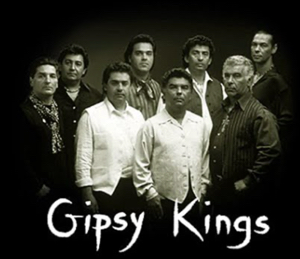Blog: Bamboleo
January 28, 2020 by Ken McNaughton

When the Gipsy Kings released their self-titled album in 1988, the number-one track was Bamboleo. Credit needs to be shared between the performers, the arrangers, Simón Díaz—the Venezuelan musician who wrote the lyrics and composed the music—and Chico Bouchikhi who, along with Nicolas Reyes and Tonino Baliardo, re-packaged it for the whole world to enjoy.
Simón Díaz, a Venezuelan singer and composer of folk music, included “Caballo Viejo” on an album of his songs in 1980, the year he turned 52. The lyrics are repetitive, but have been loosely translated below. The title means “Old Horse,” and while Diaz might have liked horses, you don’t have to be a genius to draw a parallel with people.
A horse is put out to pasture because he’s old and tired
They don’t realize that a tied-up heart,
When the reins are released
Turns into a wild horse.
And if the old horse finds a chestnut filly
His heart is unstrung; he’ll ignore the bridle,
He won’t obey the bit
And chest straps won’t stop him
A horse is put out to pasture and his days are numbered
He leaves in the morning, taking little hurried steps
To meet up with the filly that has him tied in knots
The colt has time, because of his youth
But the old horse can’t lose the flower given to him
Because after this life, there’s no other opportunity.
When love comes like this, in this way
You don’t even realize it; the fields turn green again,
The leaves and the flowers.
And the rope snaps.
When love comes like this, in this way
No one is to blame; love doesn’t keep a schedule
Or a date on the calendar,
When desires come together.
I swing, you swing
I prefer to live my life this way.
There is a YouTube video of Díaz singing his song, with blurry images of horses 1.
Ricardo Baliardo (Manitas de Plata, “Little Fingers of Silver”) and José Reyes were cousins who triggered the popularity of flamenco rumba. The sons of singer José Reyes—Nicolas, François (Canut), Andre, Patchai and Pablo (Paul)—teamed up with the sons of guitarist Ricardo Baliardo—Tonino, Diego and Paco—and achieved worldwide fame as the Gipsy Kings. When “Bamboleo” appeared on the Gipsy Kings album in 1988 it was credited to Tonino Baliardo, Jahloul “Chico” Bouchikhi and Nicolas Reyes. Tonino played lead guitar and Nicolas sang lead vocals. Chico had married a daughter of José Reyes and was a prominent member of the group in the early days but left to form his own band, Chico and the Gypsies. Arrangement duties were shared between Dominique Perrier, a French musician and composer who played synthesizers, and Gérard Prévost, who payed bass. A drummer and percussionist were also credited. There was no mention of Simón Díaz and his old horse.
Caballo Viejo starts out: “Cuando el amor llega así de esta manera” (“When love comes like this, in this way”); Bamboleo opens up “Ese amor llega así de esta manera” (“That love arrives this way”). The basic melody of Bamboleo is the same as Caballo Viejo, but the rest of the words have been mashed up. Lead singer Nicolas Reyes turned 30 in 1988, so his was a team of young colts, rather than old horses. What they found with Bamboleo was the right music to convey the universal power of attraction between the sexes, regardless of age—the passion, the forbidden nature, the flirtation, the seduction and the jealousy, as well as the danger. The real genius of the re-make was changing the title from “Old Horse”—which might not appeal to young people—to “Bamboleo,” an onomatopoeic Spanish masculine noun that means “swaying,” as in the swaying of the trees, or “swinging,” as in the swinging of chandeliers; both meanings can be applied to dancing.
I was born in 1940, during the height of the big band era, when swing was king, and dancing was mostly about moving vigorously backwards and forwards. As Latin music entered the popular charts, it was more relevant to sway gently from side to side, a fundamental shift. In 1943, Sy Oliver, an African-American big-band arranger, trumpeter, composer, singer and bandleader wrote “Opus One,” in defense of big band music with a catch line, “It’s got to swing, not sway, baby.”
There is a video to accompany the original recording of Bamboleo that conveys the Romani life, the music, and the dance between the sexes 2. One or two older folks appear, but the two central characters are about thirty years old; let’s call them Juan and María. A little Romani girl in an orange top and matching hair-piece peers through a paling fence, exclaims excitedly, turns toward the camera and walks screen right into a sunlit field. Cicadas are buzzing, a wind stirs the trees, and a rooster crows. People are lounging on shady benches. Another little girl in a yellow sun frock enters from the right and runs back. Maria looks distracted. Juan is courting her but she looks away. It is not until now that the iconic tentative opening chords of the lead guitar are introduced. A yellow car approaches through the trees. A young man plays a card. The car sweeps around a corner, kicking up dust. Other guitars join in the Catalan rumba rhythm. A fat man lying on his back lifts the hat from his eyes. Four children lean right to watch the car arrive. We hear bright rim shots on the drums and Nicolas Reyes intones the opening line, “Ese amor llega así de esta manera”—“That love arrives this way.”
People get out of the car. María breaks away from Juan, who cannot stop her. A crowd of people approaches through the yellowed fields, including members of the Gipsy Kings. They are lively, excited and moving to the music, as Nicolas breaks into “Bem, bem, bem; bem, bem, bem…” There are some close-ups of band members. Two adults in hats look to the left. There is a flourish on lead guitar and Nicolas launches into the first chorus, “Bamboleo, bambolea,”—swinging, swaying. We see a circle of seven guitarists, four on the right strumming with the right hand, and three on the left strumming with the left hand. A man twirls a girl in the dance. An older man with a white beard and red head scarf dances with a young woman, as Nicolas reaches a second “Bamboleo, bambolea.” A young boy appears to be making the rim shots. Nicolas sings “No tienes perdón de Dios”—“There is no pardon from God.”
María enters the screen from the right. Juan enters from the left, looking concerned and smoking a cigarette stub. There are several couples dancing. María, in her green satin dress, with black hair below her shoulders, dances close to Nicolas on lead guitar. A parade of young women circle Juan, who starts to dance. María looks furious, with arms crossed. Tonino breaks into the guitar solo. Juan enjoys being the center of attention. María approaches him from the right, and they confront one another. Then comes my favorite flamenco instrument, las palmas. The Gipsy Kings clap their hands contratiempo, some on beat, others off beat, so the compás is doubled. It is a sharp, dry clap, riveting in its intensity, and electrifying for dancers. Nicolas launches into a third Bamboleo chorus, and then the iconic hesitant guitar chords are repeated. María smiles. She and Juan dance. An old man at a table sways back and forth. María grabs her skirt, revealing petticoats, and dances around Juan. He pulls her toward him.
I have some fabulous memories of dancing to Bamboleo and the Gipsy Kings. On 3 July 1992, I held a party at my home in Rivercross on Roosevelt Island in New York City and played it. I asked my friend Núria Quella, from Barcelona, to dance and she said, “Oh, you are doing the Catalan rumba,” which was news to me. The Gipsy Kings were playing Radio City Music Hall and I asked my Puerto Rican friend Miriam Gonzales to come with me on 21 July 1992, the day before my birthday. We lived on opposite sides of the street and both dressed in white, meeting on the cross walk. When the curtain rose, to reveal seven guitarists through the white smoke, Miriam exclaimed, wide-eyed, “Ooh, this is wonderful!” At intermission, in the lobby, I was gazing at her and thinking how beautiful she looked. A woman came up to Miriam and said, of me, “He really loves you.”
In 1997, I took PhD physicist Tina Kaarsberg to see the Gipsy Kings at Wolf Trap in Virginia. In 1998 I took musician friend Christina van Norman to see them at Merriweather Pavilion in Columbia, Maryland. In September 1999 I went to see them alone at Pier Six in Baltimore, and went to a meet-and-greet backstage. In 2000, I took my lovely meter-maid friend Amy Biamonte to see them at Wolf Trap, and again went backstage 3. On 30 May 2001 I bought a seat and went by myself to Wolf Trap. At intermission, I went for a walk and saw some flamenco friends picnicking on the lawn. Dancer Sara Jerez invited me to join them (see photo). Shortly after, she married flamenco guitarist Richard Marlow (behind her) and they started a family. Right of her is dancer Jason Vera y Aragón and another dancer, turned away. Behind them are two Bolivian flamenco musicians, César and José Oretea, who perform as Duende Camarón. At one concert I followed two young women up the steps to dance on stage, but Nicolas met me and wagged the “no-no” finger in my face. Another time I went to an after-party and three of the Gipsy Kings showed up. It was always an ecstatic feeling to dance to Bamboleo. I have had some wonderful young female dance partners, but the music was always the true inspiration.

Ken (left foreground) joins dancer Sara Jerez and musician friends on the lawn during intermission at the Gipsy Kings concert, 30 May 2001, Wolf Trap, Virginia.
REFERENCES
- “Caballo Viejo,” Simon Diaz, YouTube video, 29 July 2008, by winterstorm2, 7.5M views, (3:05): https://www.bing.com/search?q=caballo+viejo&cvid=4a7d58dfd3174c43a228512fda0eb129&FORM=ANSPA1&PC=DCTS.
- “Bamboleo,” Gipsy Kings, YouTube video, 18 June 2010, by casper67cz, 1.727M views, (3:55): https://www.bing.com/videos/search?q=gipsy+kings+bamboleo&cvid=c1847ec49e1d49d4a923d1dadd7c34e2&PC=DCTS&ru=%2fsearch%3fq%3dgipsy%2bkings%2bbamboleo%26cvid%3dc1847ec49e1d49d4a923d1dadd7c34e2%26FORM%3dANSPA1%26PC%3dDCTS&view=detail&mmscn=vwrc&mid=DDC7EBEED094F717B3F0DDC7EBEED094F717B3F0&FORM=WRVORC.
- “My Walk with the Gypsies,” by Ken McNaughton, DCFlamenco.com, 22 January 2017: http://dcflamenco.com/my_walk_with_the_gypsies01212017.html.
COPYRIGHT This work is copyrighted and may not be reproduced in whole or in part in any medium without written permission from Ken McNaughton Living Trust, 3778 College Avenue, Ellicott City, MD 21043; phone/fax: 410-418-9340; kjmcn@comcast.net (2 August 2020)



